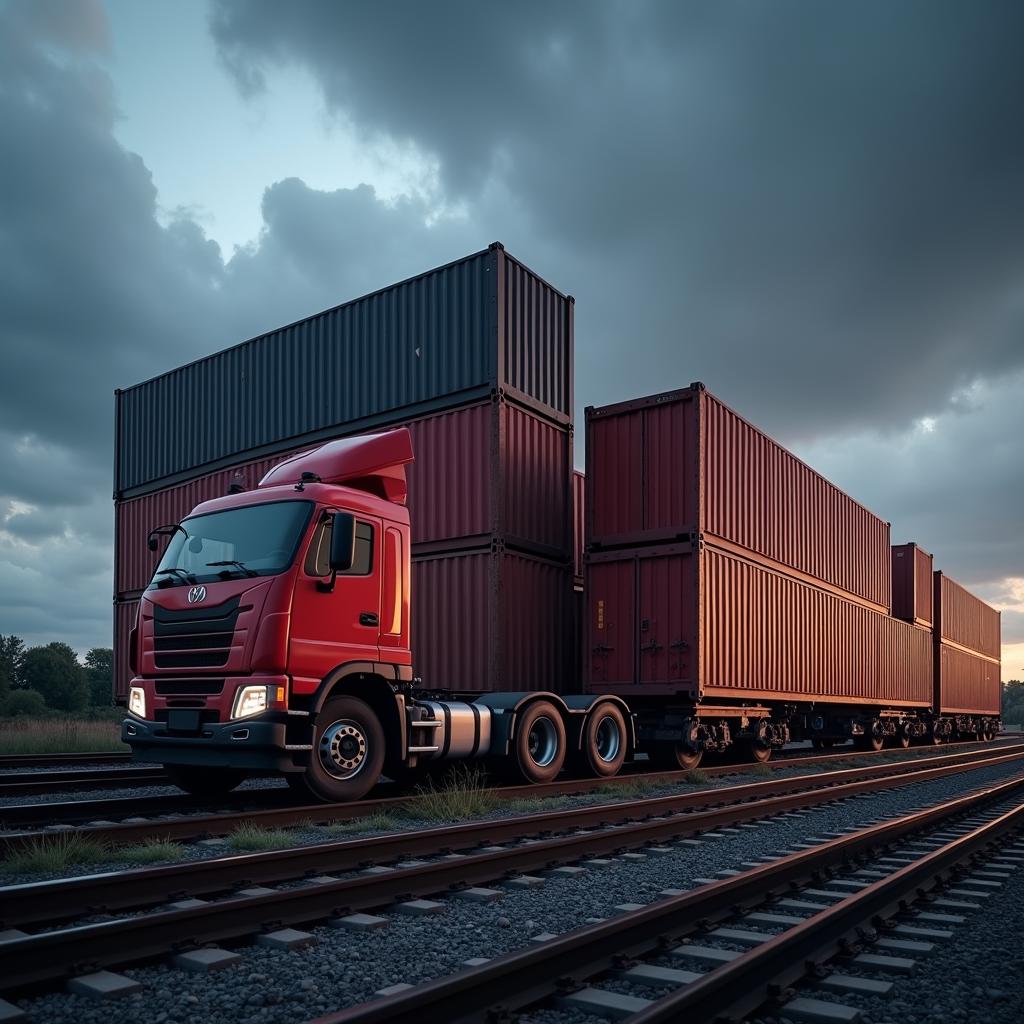Benefits of Using Intermodal Transportation for Freight
Intermodal transportation has revolutionized the shipping industry, offering unparalleled efficiency and cost-effectiveness. In this article, we dive deep into the benefits of using intermodal transportation for freight, exploring how this modern logistics solution not only reduces expenses but also promotes sustainability, increases operational connectivity, and offers a competitive edge in today’s fast-paced market.
Understanding Intermodal Transportation
Intermodal transportation involves using two or more modes of transportation—such as ships, trains, and trucks—to move freight seamlessly from the origin to the destination. This method minimizes the reliance on one specific mode and leverages the strengths of each to optimize the overall supply chain. By embracing intermodal solutions, companies can tap into savings on fuel costs, lower labor expenses, and reduce carbon footprints.
The Core Concept of Intermodal Freight
At its heart, intermodal freight is about maximizing efficiency. Rather than relying solely on trucking, companies combine different transportation modes to cover long distances or challenging terrains more effectively. The benefits of using intermodal transportation for freight are extensive, ranging from lower shipping costs to reduced environmental impacts. For instance, using rail segments for long-haul movements can significantly reduce fuel consumption compared to road haulage.
Key Benefits of Using Intermodal Transportation for Freight
Businesses choosing intermodal transportation enjoy several notable advantages. Below, we outline some core benefits while incorporating the focus on the benefits of using intermodal transportation for freight in various areas of the cargo movement landscape.
1. Cost Savings and Improved Efficiency
One of the primary benefits of using intermodal transportation for freight is the reduction in transportation expenses. By shifting a portion of the shipment to rail or water transport, companies can reduce fuel costs, lower maintenance expenses, and minimize wear and tear on road vehicles. In addition, intermodal solutions help reduce labor costs by optimizing schedules and routes, which can lead to fewer delays and disruptions.
- Lower fuel consumption when using trains for long hauls
- Optimized routing resulting in less downtime
- Reduced vehicle wear and tear
- Bulk shipment advantages reducing per-unit costs
Moreover, the consolidation of shipments into standardized containers minimizes handling charges and speeds up transit times. This integration directly contributes to overall savings, making intermodal transportation an attractive option for businesses looking to maintain lean operations.
2. Environmental Advantages
The environmental benefits of using intermodal transportation for freight cannot be overstated. Utilizing trains and ships in place of trucks for the longest portions of a shipment reduces fuel consumption dramatically and curbs greenhouse gas emissions. This greener approach aligns with global efforts to combat climate change and promotes sustainable supply chain practices.
According to the U.S. Environmental Protection Agency (EPA), employing rail and water transport modes can cut emissions by up to 75% compared to truck-only shipments. These impressive statistics underscore how companies can contribute to environmental conservation while reaping financial benefits.
3. Enhanced Reliability and Safety
Intermodal transportation is designed to improve the overall reliability and safety of freight shipments. By leveraging the strengths of diverse transportation methods, companies can minimize risks associated with road congestion, weather-related delays, and accidents. The controlled environment of rail and ship transport offers significantly higher levels of security and cargo protection.
Features such as standardized containers reduce the chances of cargo damage and simplify the loading and unloading process. This controlled handling environment minimizes errors and improves shipment tracking, making it easier to maintain compliance with safety regulations and industry standards.
4. Flexibility and Scalability in Operations
Flexibility is another major advantage described among the benefits of using intermodal transportation for freight. Companies can scale their operations according to market demand without being overly reliant on a single mode of transport. This adaptability makes it simpler to navigate market fluctuations and changing logistics requirements.
For example, businesses can leverage additional rail capacity during peak seasons or pivot to road transport for last-mile delivery, ensuring that the supply chain remains responsive and resilient. This flexibility is essential for companies looking to remain competitive in ever-changing market conditions.
5. Improved Supply Chain Visibility and Coordination
Modern intermodal transportation often integrates advanced tracking and logistics software, enhancing supply chain visibility and coordination. Real-time tracking enables companies to monitor shipments closely, allowing for proactive problem-solving and streamlined communication across different modes of transportation.
Enhanced visibility ensures that all parties, from suppliers to end customers, are kept informed. This level of coordination is vital for just-in-time (JIT) manufacturing and inventory management practices, further positioning the benefits of using intermodal transportation for freight as key to modern business competitiveness.
Operational Efficiency through Modern Technology
Technology Integration in Intermodal Freight
Technology plays a central role in harnessing the benefits of using intermodal transportation for freight. Digital platforms link different transportation segments, optimizing the logistics chain through real-time data exchange and comprehensive monitoring. This connectivity results in improved planning, better inventory management, and accelerated problem resolution.
Systems for electronic documentation and automated tracking streamline operations, reducing manual keying errors and paperwork. This digitalization ensures that all stakeholders have accurate, up-to-date information, driving efficiencies that translate into tangible savings and improved service levels.
Real-Time Tracking and Analytics
Another essential aspect of modern intermodal transportation is the deployment of real-time tracking systems. These systems provide stakeholders with continuous updates on cargo status, ensuring timely responses to any disruptions. Advanced analytics further enhance decision-making by predicting potential bottlenecks and optimizing scheduling adjustments.
Through such integrated technological solutions, companies can fully realize the benefits of using intermodal transportation for freight by reducing delays and enhancing overall operational responsiveness.
The Impact on Global Trade and Economic Growth
Boosting Global Trade
When companies adopt intermodal transportation strategies, they not only optimize their own operations but also contribute to broader economic growth. Enhanced freight connectivity between ports, railheads, and distribution centers facilitates international trade by minimizing delays and reducing shipping costs.
This seamless integration particularly benefits emerging economies by providing them with access to efficient and affordable logistics solutions. Global trade networks become more resilient as intermodal transportation smooths out interruptions and promotes steady economic development.
Creating New Business Opportunities
The benefits of using intermodal transportation for freight extend to the creation of new business opportunities. As companies achieve savings and environmental compliance, they are free to invest in other areas of innovation and expansion. Additionally, economic zones around intermodal hubs often flourish, attracting ancillary businesses ranging from warehousing services to technology providers.
The multiplier effect of these benefits stimulates local job creation, drives infrastructure development, and nurtures a competitive global marketplace.
Cost Comparison: Intermodal Transportation vs. Traditional Trucking
Making a detailed cost comparison between traditional trucking and intermodal solutions highlights significant savings potential. The table below summarizes the key cost factors and operational efficiencies of each method.
| Cost Factor | Traditional Trucking | Intermodal Transportation |
|---|---|---|
| Fuel Efficiency | Lower fuel economy due to constant stop-and-go | Higher efficiency with rail and ship segments |
| Labor Costs | Higher due to continuous driver requirements | Lower through consolidated shipping segments |
| Maintenance | More wear in heavy-duty trucks | Less frequent maintenance due to diversified transport methods |
| Emission Levels | High carbon footprint | Reduced emissions and improved sustainability |
This cost comparison clearly demonstrates how intermodal logistics not only lower expenses but also contribute significantly to operational efficiency and sustainability goals.
Implementing Intermodal Strategies in Your Business
Steps to Transition to Intermodal Transportation
To successfully tap into the benefits of using intermodal transportation for freight, businesses need to follow a structured approach. Consider these steps to transition your logistics operations:
- Conduct a Feasibility Study: Assess your current logistics and freight handling processes to identify potential areas for intermodal integration.
- Collaborate with Experienced Partners: Establish relationships with reliable transportation providers who have expertise in intermodal shipping. Visit our services page to learn more about our integrated solutions.
- Invest in Technology: Implement digital tools for real-time tracking and documentation management.
- Optimize Supply Chain Routes: Redesign your routes to leverage rail and water shipping where suitable and maximize the overall transit efficiency.
- Train Your Team: Educate your staff on the new processes and technological tools required to handle intermodal shipments.
Aligning with Regulatory and Environmental Standards
Adopting intermodal transportation methods also means aligning with global environmental and regulatory standards. Governments and international bodies are increasingly prioritizing eco-friendly logistics practices. Companies can access useful guidelines and suggestions on federal transportation regulations through the U.S. Department of Transportation (DOT).
Complying with these standards not only avoids penalties but also reinforces the reputation of your business as environmentally responsible—a key selling point in today’s market.
Industry Trends and Future Prospects
Modernization in Transportation Infrastructure
Investments in infrastructure continue to boost the adoption of intermodal transportation across the globe. New rail lines, upgraded port facilities, and improved road connections contribute significantly to making this mode of freight transport more reliable and cost-effective. These developments directly amplify the benefits of using intermodal transportation for freight by facilitating faster transfers, lower costs, and improved sustainability.
Innovations in Container Technology
Advances in container design and handling are further enhancing the intermodal model. Smart containers equipped with sensors for real-time data monitoring reduce losses and improve cargo integrity. These cutting-edge innovations allow for even greater operational efficiency, ensuring that freight is not only transported faster but also arrives in optimal condition.
Long-Term Market Impact
The long-term impact of intermodal transportation is vast. As more companies recognize the strategic advantages, market trends indicate a steady increase in intermodal shipping adoption. This shift paves the way for a more responsive, cost-effective, and environmentally friendly logistics ecosystem—factors that are expected to redefine the future of global trade.
Leveraging Intermodal Transportation in a Digital Age
Integrating IoT and Data Analytics
The digital revolution has led to the integration of the Internet of Things (IoT) in transportation systems, elevating the precision with which intermodal logistics are managed. Sensors installed in cargo containers, along with data analytics platforms, offer insights into transit conditions, environmental factors, and potential operational issues before they escalate. This technology is one of the many benefits of using intermodal transportation for freight, providing real-time decision-making tools and forecasting capabilities.
Enhancing Customer Experience through Transparency
Today’s customers demand transparency, especially in logistics. Real-time tracking enables businesses to share accurate shipment statuses with their clients. This transparency not only builds trust but also enhances customer satisfaction. Integrating advanced APIs and tracking platforms can transform back-end processes and further reinforce the benefits of using intermodal transportation for freight by ensuring efficient communication across the supply chain.
How Intermodal Transportation Shapes the Future of Freight
Evolving Business Models
As global commerce expands and consumer expectations continue to rise, innovative business models emerge that capitalize on the unique advantages of intermodal transport. Companies are finding creative ways to integrate multiple transportation modes into their supply chains, reducing dependency on fluctuating oil prices and labor markets. These evolving models underscore the endless potential and sustainability of the intermodal system.
Strengthening Resilience in Supply Chains
Disruptions in any part of the supply chain often lead to cascading delays and losses. The diversified nature of intermodal transportation acts as a buffer against such uncertainties. By using various transportation channels, companies can maintain steady flow in case one mode faces challenges, thereby enhancing overall supply chain resilience.
Competitive Advantages in Global Markets
Ultimately, the benefits of using intermodal transportation for freight extend to offering a competitive edge in the global marketplace. Organizations capable of leveraging these advantages can achieve quicker turnaround times, cost reductions, and sustainability achievements that distinguish them from competitors.
Case Studies: Successes in Intermodal Transportation
Case Study 1: Reducing Transit Time in North America
A leading manufacturing company in North America restructured its logistics network by integrating rail and truck transportation. The new intermodal approach not only cut transit times by 30% but also resulted in a 25% reduction in overall logistics expenses. Enhanced real-time tracking and improved supply chain coordination were pivotal to this success, reiterating the benefits of using intermodal transportation for freight.
Case Study 2: Environmental Impact and Cost Efficiency in Europe
In Europe, a major retailer shifted a significant portion of its long-haul cargo to rail networks to mitigate environmental impacts. The reduction in carbon emissions helped the company meet stringent environmental regulations while simultaneously decreasing operational costs. The dual focus on financial savings and sustainability perfectly illustrates how modern businesses can harness intermodal transportation to drive success.
Integrating Intermodal Transportation with Your Logistics Strategy
Understanding Your Current Logistics Network
The first step in integrating intermodal transportation involves mapping out your current logistics network. Identify gaps and inefficiencies where a multimodal approach can make a difference. Use internal resources like your company’s logistics dashboard or consult with experts to get an accurate assessment of potential improvements.
Working with Trusted Partners
Strong partnerships can make or break the implementation of an intermodal strategy. Companies like Movex Group have extensive experience in coordinating complex logistics operations. Learn more about our approach to innovative intermodal solutions by visiting our blog and contact page to discuss how our expertise can enhance your supply chain operations.
Monitoring, Adjusting, and Scaling Your Operations
Once the intermodal framework is in place, continuous monitoring is essential. Leverage data analytics to identify trends and areas for further improvement. As your operations stabilize, gradually scale your intermodal integrations to capture even more savings and operational efficiencies. Ongoing training for your staff and regular reviews of your logistics processes can help sustain long-term success.
Conclusion
Intermodal transportation is much more than a trend—it is a strategic asset that offers a comprehensive array of benefits for modern businesses. The benefits of using intermodal transportation for freight include significant cost savings, enhanced environmental performance, operational resilience, and improved supply chain visibility. As companies worldwide navigate the complexities of logistics and global trade, intermodal strategies provide the flexibility and efficiency required to remain competitive. Embracing this integrated approach not only supports sustainability initiatives but also sets the foundation for future growth and innovation.
Frequently Asked Questions (FAQs)
1. What exactly is intermodal transportation?
Intermodal transportation is the process of moving freight using multiple modes of transport—such as ships, trains, and trucks—without handling the freight itself when changing modes. This method streamlines the shipping process and minimizes handling damage.
2. How do the benefits of using intermodal transportation for freight affect overall shipping costs?
By optimizing the freight movement with cost-effective modes such as rail and water, companies can reduce fuel consumption, maintenance expenses, and labor costs, leading to considerable overall shipping cost savings.
3. Can intermodal transportation help improve environmental sustainability?
Yes, intermodal transportation typically relies on more fuel-efficient modes like rail and ships, significantly reducing greenhouse gas emissions compared to traditional trucking, thereby promoting a greener supply chain.
4. What role does technology play in intermodal logistics?
Technology plays a crucial role by facilitating real-time tracking, automated documentation, and data analytics. These tools enhance communication, allow for proactive decision-making, and ensure a seamless integration of different transport modes.
5. How can my company start implementing intermodal transportation solutions?
Begin by evaluating your current logistics network, set clear objectives, and establish partnerships with experienced logistics providers. Invest in technology for tracking and planning, and gradually transition parts of your routes to intermodal solutions for maximum benefits.







